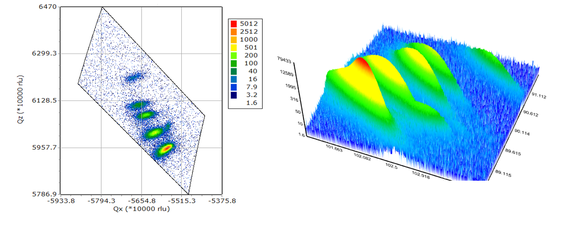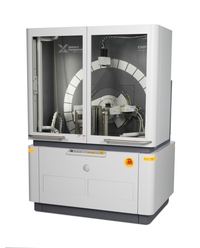Reciprocal space analysis
Advanced X-ray characterization

Advanced X-ray characterization

Reciprocal space mapping is a high-resolution X-ray diffraction method to measure a reciprocal space map (RSM).
These maps around reciprocal lattice spots can reveal additional information beyond that provided by single line scans such as high-resolution rocking curves.
RSMs are typically used to aid the interpretation of peak displacement, peak broadening, or peak overlap.
The relaxation of lattice strain in epitaxial buffer layers and virtual substrates is often accompanied by layer tilting, resulting in peak displacement. Bragg peaks of asymmetric reflections are also displaced in rocking curves as a result of epitaxial strain.
Mismatch and threading dislocations in semiconductor epitaxial layers can give rise to peak broadening and peak overlap in traditional high-resolution rocking curve measurements.
Measuring RSM is a way of separating these effects so that Bragg peak positions can be precisely measured.
This is important for the determination of strain, lattice relaxation, composition and layer thickness in compound semiconductors, such as GaN-based devices for high mobility electron transistors (HEMTs) and LEDs.

Reciprocal space mapping is particularly powerful for the general investigation of layer quality in thin layered structures.
When there are defects in an epitaxial layer, it is broken into mosaic blocks which are perfect regions of crystal that are tilted or rotated with respect to each other. Similarly, crystal grains in polycrystalline deposited layers may share a common (fiber) orientation.
Reciprocal space mapping can be used to measure the size and relative tilts of mosaic blocks and to investigate texture in deposited films.
Reciprocal space maps can also clearly distinguish peak broadening arising from this mosaicity from peak broadening due to other effects such as substrate curvature.
Recent advances in data streaming and management mean that, for all but the highest resolution applications, the PIXcel3D detector can be used for ultra-fast reciprocal space mapping (URSM).
Larger areas of reciprocal space can be covered in shorter times than ever before.
For example, the full (0002) reciprocal space map of GaN alloy layers on sapphire, can be collected in as little as 30 seconds. Watch the full video below:

Empyrean rangeMultipurpose X-ray diffractometers for your analytical needs |

X'Pert³ MRDVersatile research & development XRD system |

X'Pert³ MRD XLVersatile research, development & quality control XRD system |
|
|---|---|---|---|